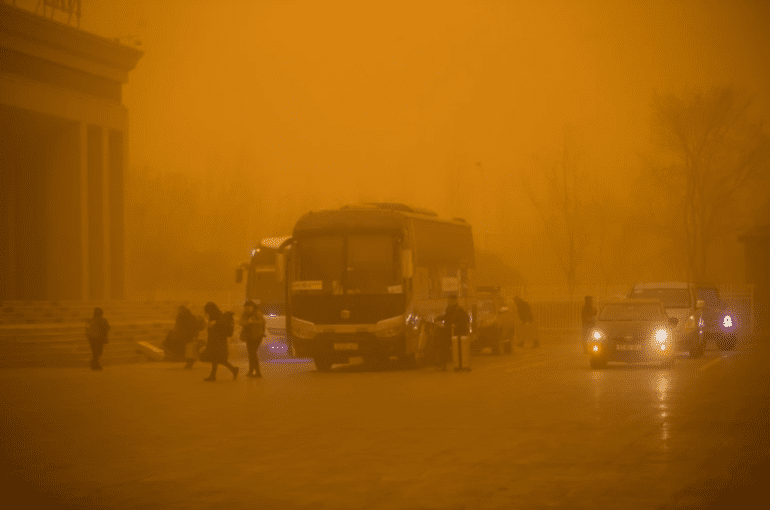- Asia faces annual dust storms, prompting the need for accurate prediction.
- Chinese researchers utilize AI and climate modeling to enhance forecasting.
- AI-driven systems like the Dust Watcher offer improved accuracy and early warnings.
- Challenges include refining forecasting tools for densely populated regions.
- Climate change impacts dust storm dynamics, with potential mitigating effects.
- Collaboration and investment are vital for effective dust storm mitigation efforts.
Main AI News:
As the Northern Hemisphere welcomes spring, numerous Asian countries brace themselves for an annual challenge: dust storms. Last month, parts of China’s Inner Mongolia witnessed skies turning murky yellow, prompting residents to stay indoors as winds surged up to 100 kilometers per hour, reducing visibility to less than 90 meters. The threat extended to Beijing, where inhabitants were cautioned to shutter windows and take precautions against the advancing dust from Mongolia and China’s Inner Mongolia.
Despite decades of research by Chinese scientists and the development of forecasting systems, challenges persist in accurately predicting the onset, intensity, and trajectory of dust storms. Errors in existing systems underline the need for more effective solutions. In response, researchers across the region are leveraging artificial intelligence (AI) and climate modeling to enhance predictive capabilities, potentially saving millions annually. In the first quarter of 2021 alone, northern China incurred losses exceeding 30 million yuan (US$4.15 million) due to dust storms, impacting agriculture and infrastructure.
Drifting Threats
Dust storms materialize when fierce winds sweep through arid landscapes like deserts, lifting dust particles into the air, sometimes soaring as high as 1,500 meters. These storms can coalesce into massive, swiftly advancing walls of dust, posing hazards to health and the environment. Laden with bacteria and toxic metals, they escalate mortality rates from cardiovascular and respiratory ailments by 25% and 18%, respectively. Additionally, soil erosion during these storms can diminish crop yields by up to 24% in Mongolia, exacerbating food security challenges.
Globally, sand and dust storms affect 334 million people, with the Sahara Desert serving as the primary source of airborne particulates. Dr. Chen Siyu, an atmospheric scientist based in Lanzhou, strategically located near the Gobi Desert, emphasizes the urgency of predictive measures. Her team has pioneered an AI-driven early-warning system, aptly named the Dust Watcher, to anticipate the timing and severity of impending storms.
Harnessing AI for Clarity
Dr. Huang Jianping, a leading expert in dust dynamics at Lanzhou University, highlights AI’s capacity to analyze vast datasets encompassing ground-level observations, satellite imagery, and computational models. In 2021, Dr. Chen and her team deployed AI to refine forecasting models for North and East Asia, yielding a 13% reduction in prediction errors compared to traditional methods. The Dust Watcher’s potential has garnered interest from meteorological institutions in China, with plans underway for a public-facing mobile application.
Navigating Forecasting Challenges
Dust storms pose acute risks in densely populated regions of East Asia, necessitating precise forecasting tools. Dr. Jin Jianbing and his team at Nanjing University of Information Science and Technology have developed the Dust Assimilation and Prediction System (DAPS), integrating observational data and model simulations to generate accurate forecasts. Leveraging AI, DAPS offers detailed predictions regarding dust dispersion and concentration across China, Mongolia, and both Korea and Japan.
Climate Change Complexities
While climate change exacerbates many extreme weather phenomena, its impact on dust storms is nuanced. Recent research suggests Arctic amplification, driven by climate change, may reduce dust levels in West and South Asia by altering wind patterns. However, in Pakistan, dust exacerbates air pollution and disrupts rainfall patterns, potentially intensifying flood risks. Collaborative efforts across Asian countries are crucial for improving forecasting accuracy and mitigating the impacts of dust storms.
Conclusion:
The integration of AI into dust storm prediction systems presents lucrative opportunities in the meteorological market. Businesses specializing in AI-driven weather forecasting technologies stand to benefit from increased demand for more accurate and timely predictions, particularly in regions prone to dust storms. Moreover, as climate change continues to influence weather patterns, there is a growing need for innovative solutions to mitigate the impacts of extreme weather events. Investing in research and development in this sector could yield substantial returns and contribute to societal resilience against environmental challenges.

